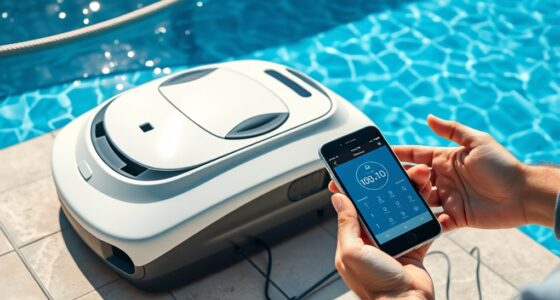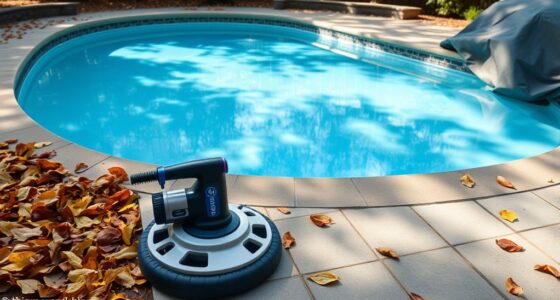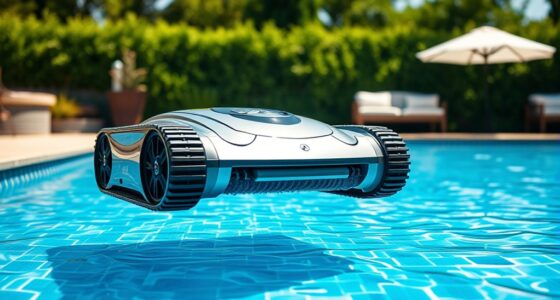To service your robotic pool cleaner, start by spotting signs like poor cleaning, strange noises, or unusual vibrations. Turn it off, unplug, then inspect and clean filters, brushes, and accessible parts. Replace worn filters and damaged brushes as needed. Regularly check for corrosion and update firmware. Proper maintenance prevents breakdowns and keeps it running smoothly. For detailed steps on cleaning, inspecting, and replacing parts, continue exploring these helpful tips.
Key Takeaways
- Service your cleaner when you notice irregular cleaning, unusual noises, or navigation issues to prevent further damage.
- Turn off and unplug the device before inspecting or cleaning components to ensure safety.
- Regularly check and replace filters and brushes based on manufacturer guidelines to maintain optimal performance.
- Clean filters, brushes, and accessible parts weekly to prevent clogs and extend the cleaner’s lifespan.
- Store your cleaner in a dry, shaded area and perform routine maintenance to ensure longevity and efficiency.
Recognizing Signs That Indicate Your Cleaner Needs Servicing
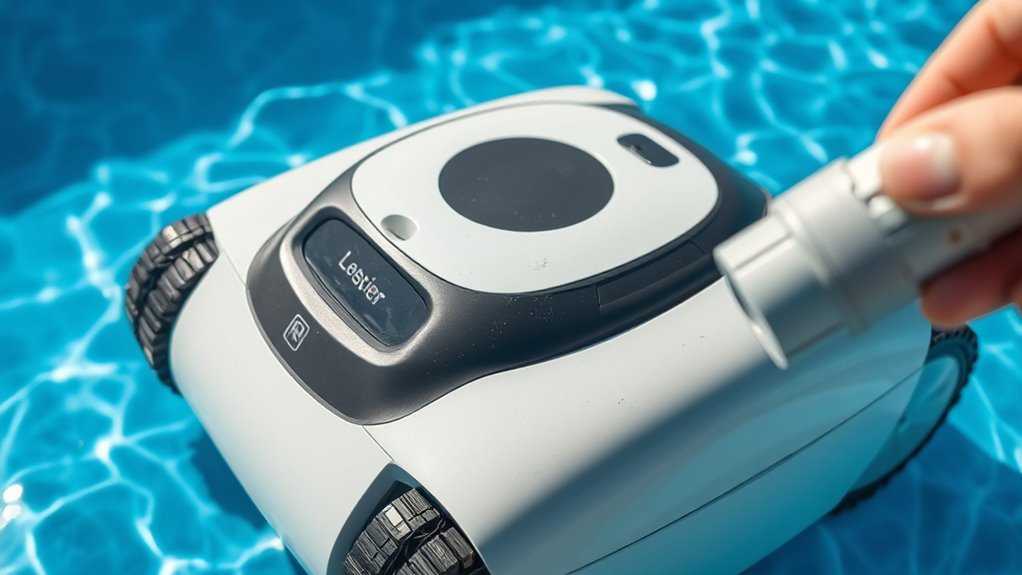
If your robotic pool cleaner isn’t performing as well as it used to be, it’s a clear sign that it may need servicing. One key indicator is signs of malfunction, such as inconsistent cleaning patterns or areas left uncleaned. Unusual noises, like grinding or squealing sounds, also point to potential issues with the motor or brushes. If your cleaner suddenly stops mid-cycle or struggles to navigate the pool, these are red flags that something’s wrong. Pay attention to any abnormal vibrations or strange smells, which can signal internal problems. Addressing these signs early can prevent more extensive damage and ensure your cleaner continues to operate efficiently. Regularly monitoring its performance helps you catch issues before they escalate. Additionally, understanding routine maintenance in pool equipment can sometimes inspire maintenance routines that keep your equipment in top shape. Moreover, staying aware of signs of malfunction can help you troubleshoot and schedule repairs promptly, saving time and money. Performing preventative care can further extend the lifespan of your robotic cleaner and maintain its cleaning efficiency.
Preparing Your Robotic Pool Cleaner for Maintenance
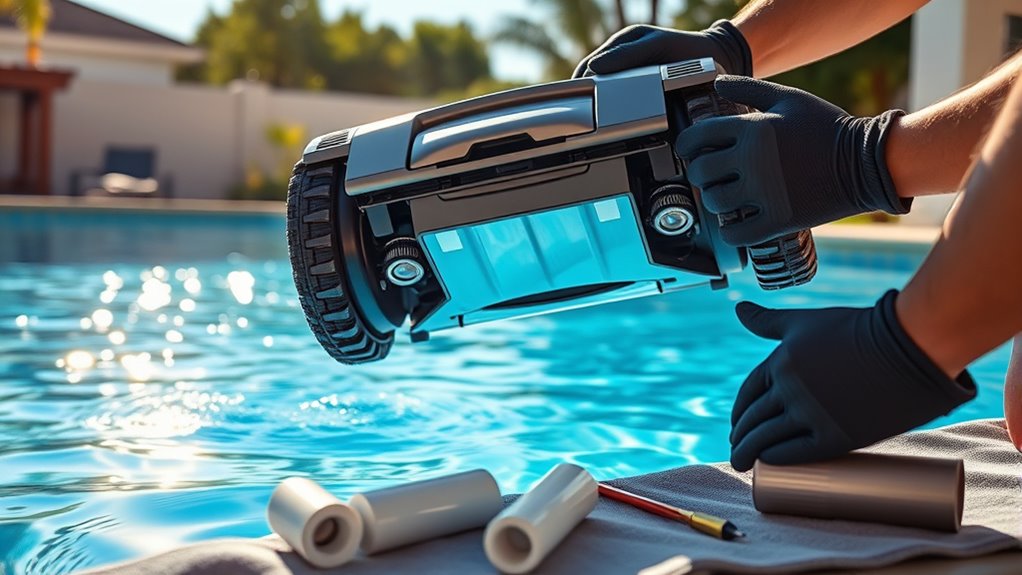
Before you start any maintenance, turn off your robotic pool cleaner and unplug it from the power source to guarantee safety. Begin by inspecting the battery compartment for any signs of corrosion or damage. If your cleaner’s battery isn’t holding a charge, you might need a battery replacement to ensure maximum operation. Check for firmware or software updates from the manufacturer’s website, as keeping your cleaner’s software current can improve performance and fix bugs. Confirm the power supply and charging station are functioning properly. Remove any debris or dirt from filters and accessible parts, preparing your cleaner for more detailed inspection. Taking these initial steps helps prevent issues during routine cleaning and ensures your robotic pool cleaner remains in top condition. Regular maintenance can also help in controlling dirt buildup, prolonging the lifespan of your device.
Step-by-Step Guide to Cleaning and Inspecting Components
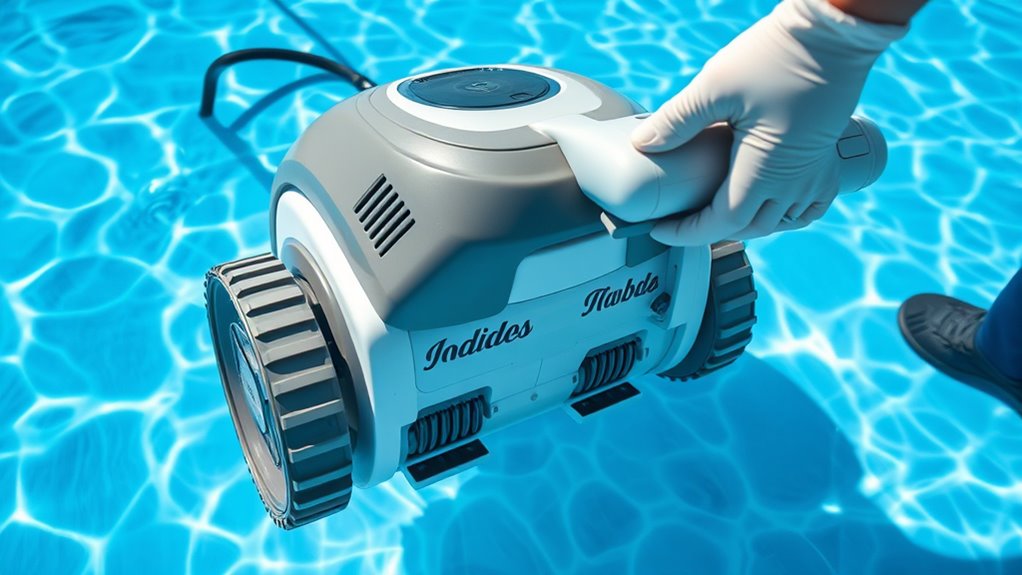
To effectively clean and inspect your robotic pool cleaner’s components, start by removing the main body and carefully detaching the brushes, filters, and any accessible parts. Check for debris or buildup that could cause troubleshooting issues, like reduced suction or movement problems. Use a hose or soft brush to remove dirt and debris from filters and brushes, ensuring they’re free of obstructions. Inspect the brushes for wear and tear, replacing if necessary. Proper storage tips involve drying components thoroughly before reassembly and keeping them in a cool, dry place away from sunlight. Regular cleaning and inspection help prevent future issues, extend the cleaner’s lifespan, and keep it functioning at peak performance. Incorporating routine maintenance into your schedule can significantly reduce the likelihood of mechanical failures. Additionally, understanding Toyota Tuning options can inspire modifications that further optimize your equipment’s performance. Being aware of beach environment factors, such as sand and salt, can also help you perform more effective cleanings and avoid damage. This routine makes troubleshooting easier and keeps your pool cleaner in top shape, especially considering that aftermarket parts can sometimes improve durability and efficiency. Recognizing signs of mechanical failure early can save you time and money on repairs.
When and How to Replace Parts and Filters

Knowing when to replace parts and filters is key to keeping your robotic pool cleaner performing at its best. Regular filter replacement ensures debris doesn’t clog the system, maintaining peak suction and cleaning efficiency. Check your filters weekly; if they appear dirty or clogged after rinsing, replace them to prevent strain on the motor. Proper maintenance practices can significantly extend the lifespan of your device and ensure optimal operation. Motor inspection is equally important—listen for unusual noises or observe any loss of power, which may indicate the motor needs servicing or replacement. If your cleaner’s performance declines despite cleaning the filters, consider replacing worn-out parts or the motor itself. Always follow the manufacturer’s guidelines for part and filter replacement intervals, and use compatible components to ensure your robotic pool cleaner runs smoothly and lasts longer. Market growth in AI technology highlights how automated systems are becoming increasingly sophisticated, making preventative maintenance even more crucial to prevent unexpected failures and ensure safety. Regularly monitoring system performance can help you identify potential issues early and avoid costly repairs.
Tips for Ongoing Maintenance to Keep Your Cleaner in Top Condition
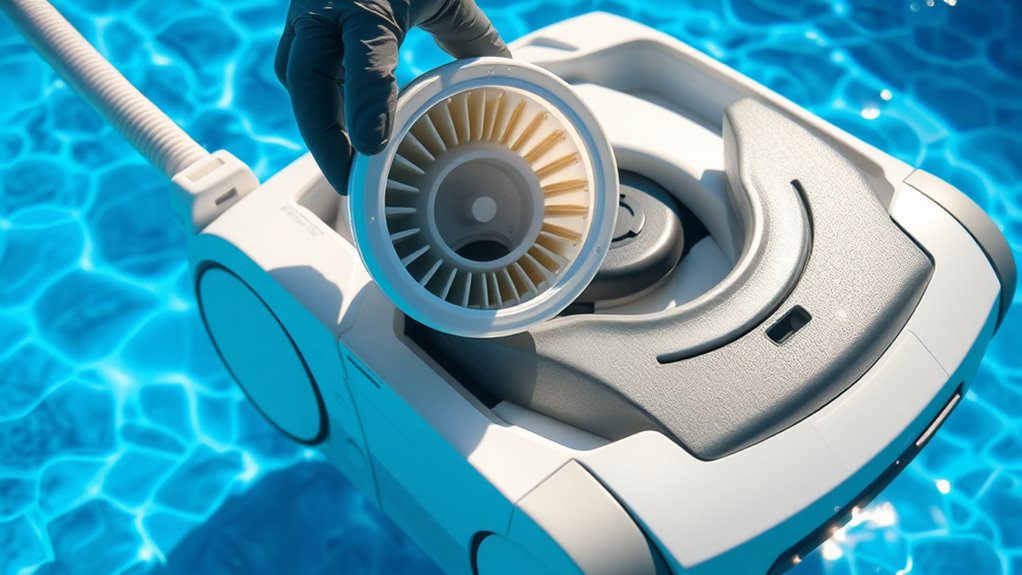
Regularly inspecting and cleaning your robotic pool cleaner is essential for maintaining ideal performance. This helps guarantee optimal cleaning, energy efficiency, and prolongs the unit’s lifespan. Check the brushes and wheels for debris and wear, and clean filters regularly to maintain proper water flow. Maintaining proper pool chemical balance prevents algae and mineral buildup that can hinder your cleaner’s operation. Keep cords untangled and store your cleaner in a shaded, dry area when not in use to prevent damage. Use the following table as a quick reminder:
| Maintenance Task | Benefits |
|---|---|
| Clean brushes and filters | Better cleaning, efficiency |
| Check for debris | Prevent clogs and damage |
| Maintain chemical balance | Prevent buildup, save energy |
| Store properly | Extend lifespan |
| Regular inspections | Detect issues early |
Additionally, leveraging automation’s role in business intelligence can help monitor your cleaner’s performance over time, enabling proactive maintenance. Regular performance tracking can identify wear and tear before they lead to major malfunctions, ensuring your cleaner operates at peak efficiency. Incorporating remote monitoring systems can further enhance your ability to oversee your pool cleaner’s condition from afar. Implementing predictive maintenance techniques can also reduce unexpected breakdowns by analyzing usage patterns and early warning signs. Using data-driven insights, you can optimize maintenance schedules and avoid costly repairs.
Frequently Asked Questions
How Often Should I Schedule Professional Servicing for My Robotic Pool Cleaner?
You should schedule professional servicing for your robotic pool cleaner at least once a year. During these visits, routine inspections guarantee it operates efficiently, and any worn or damaged parts can be replaced before issues worsen. Regular maintenance helps extend its lifespan and keeps cleaning performance at its best. Keep an eye on performance between services, and don’t hesitate to seek professional help if you notice unusual noises or decreased suction.
Can I Use Household Cleaning Agents to Maintain My Robotic Pool Cleaner?
Imagine your robotic pool cleaner battling stubborn grime, only to be damaged by harsh household chemicals. You might think cleaning solutions are safe, but they can corrode delicate parts or leave residues that hinder performance. Using household chemicals on your cleaner risks costly repairs. Stick to manufacturer-recommended cleaning agents, ensuring your robot stays in top shape and keeps your pool sparkling without unexpected setbacks.
What Specific Tools Are Recommended for Disassembling My Robotic Pool Cleaner?
To disassemble your robotic pool cleaner, you’ll need the right disassembly tools, such as screwdrivers, pliers, and sometimes a small wrench. A maintenance kit often includes these tools along with brushes and replacement parts, making it easier to perform routine upkeep. Always follow manufacturer instructions for disassembly to avoid damage, and keep your tools organized for quick access during cleaning or repairs.
Is It Safe to Operate My Cleaner Immediately After Cleaning and Maintenance?
Your pool cleaner is a superhero, but even heroes need a break! It’s not safe to operate your robotic pool cleaner immediately after cleaning and maintenance. You should follow safety precautions, like inspecting for any damage and ensuring all parts are dry. Wait until everything is completely dry and double-check that no debris is caught. This way, you prevent damage and keep your cleaner working flawlessly. Always prioritize safety precautions for immediate operation.
How Do I Troubleshoot Connectivity Issues With My Robotic Pool Cleaner?
If you’re facing connectivity issues with your robotic pool cleaner, start by checking for Wi Fi interference from other devices or thick walls blocking signals. Make certain the cleaner’s battery isn’t low, as battery issues can disrupt connection. Restart your Wi Fi router and reconnect your cleaner. Keep the firmware updated and place your router closer to the pool area if needed. These steps often resolve common connectivity problems efficiently.
Conclusion
By following these simple steps and staying vigilant, you’ll guarantee your robotic pool cleaner continues to conquer grime and grime with ease. Regularly review, rinse, and replace components to keep it performing perfectly. Stay proactive with periodic inspections, prevent problems before they arise, and enjoy pristine, sparkling water all season long. With consistent care and clever maintenance, your cleaner will glide gracefully, guaranteeing a gleaming, glorious pool that’s ready for relaxation anytime you plunge in.


